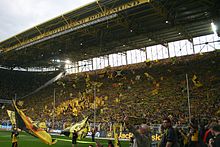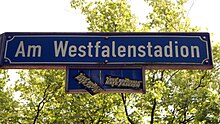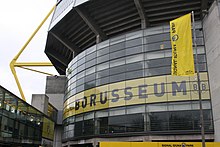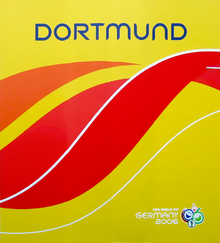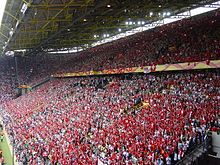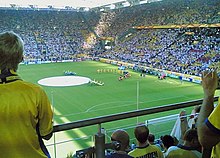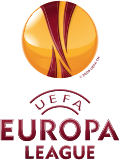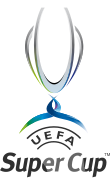Signal Iduna Park
| Westfalenstadion Signal Iduna Park |
|
|---|---|
|
|
|

|
|
| Aerial view of the stadium | |
| Sponsor name (s) | |
|
|
| Data | |
| place | Strobelallee 50 44139 Dortmund , Germany |
| Coordinates | 51 ° 29 '33.6 " N , 7 ° 27' 6.4" E |
| classification | 4th |
| owner | Borussia Dortmund GmbH & Co. KGaA |
| operator | Borussia Dortmund GmbH & Co. KGaA |
| start of building | 1971 |
| opening | April 2nd 1974 |
| First game | TBV Mengede - VfB Waltrop 1: 2 |
| Renovations | 1992, 2005, 2006, 2007, 2008, 2010, 2011, 2012, 2014, 2019 |
| Extensions | 1995-1999, 2002-2003 |
| surface | Hybrid lawn |
| costs | 200 million euros (estimated) |
| architect | 1971–1974: Building Department Dortmund; 1st and 2nd expansion stage: Ulrich Drahtler / GSP Dortmund; 3rd expansion stage: Architects Schröder Schulte-Ladbeck ; 4th expansion stage WM 2006 / further modifications and expansions: Planungsgruppe Drahtler GmbH, Dortmund |
| capacity | 81,365 seats |
| Capacity (internat.) | 66,099 seats |
| Societies) | |
| Events | |
The Signal Iduna Park (spelling: SIGNAL IDUNA PARK ; BVB Stadium Dortmund free of advertising in UEFA competitions ), until December 2005 and in parlance also Westfalenstadion , is a football stadium in the city center-west district of the North Rhine-Westphalian city of Dortmund . With 81,365 spectator seats - for national soccer games such as the Bundesliga and DFB Cup - it is the largest soccer stadium in Germany. For international matches (e.g. international matches , Champions League or Europa League ) there are 66,099 seats. The stadium is located on Strobelallee and has been the venue of the Bundesliga soccer club Borussia Dortmund since 1974 and has already hosted international soccer tournaments on several occasions. a. the soccer world championship 1974 and most recently the soccer world championship 2006 as well as home games of the German national team. The UEFA category 4 stadium with the striking yellow pylons of the roof structure is a landmark of the city of Dortmund.
history
The stadium was built between 1971 and 1974 for the 1974 World Cup with a seating capacity of 54,000. It cost 31.7 million DM, a relatively cheap price for a stadium of this size: the council and administration of the city of Dortmund had decided to build a prefabricated pallet stadium. The federal government and the state of North Rhine-Westphalia bore the majority of the construction costs .
The stadium was opened on April 2, 1974 with a charity match between Borussia Dortmund and old rival Schalke 04 , who competed in favor of the economically troubled BVB without a fee. Schalke won 3-0. The women's teams of Dortmund TBV Mengede 08 and VfB Waltrop played the prelude (1: 2). In this game Margarethe Schäferhoff scored the first goal in the Westfalenstadion at 6:18 p.m.
On April 7, 1974, the first league game between Borussia Dortmund and Bayer Uerdingen took place in the new stadium. It ended goalless. The first Bundesliga match that was played in this stadium took place on April 2, 1976 between VfL Bochum (who moved here during the construction of the Ruhr Stadium in April 1976) and FC Schalke 04 (1: 4); Erwin Kremers was the first to score in a Bundesliga match . Borussia itself was still playing in the 2nd Bundesliga North at that time.
The stadium remained structurally almost unchanged until the early 1990s. In 1992 the building department of the city of Dortmund converted from standing to seating. The standing room on the north stand became seated, reducing the capacity to 42,800.
On May 16, 2001, the final of the 2000/01 UEFA Cup between Liverpool FC and Deportivo Alavés took place in the Westfalenstadion . Liverpool won the game 5-4 after a golden goal .
Reconstruction and expansion
A first phase of renovation was carried out between 1995 and 1999. The aim was to increase and expand by building an upper tier. The architect in charge of the 1st and 2nd expansion stages was Ulrich Drahtler from the Dortmund architectural office Gustav Schulze und Partner, the structural engineer from Engels Ingenieure Dortmund. It started with the west and east stands on the long sides of the field. After the expansion of the two grandstands, the Westfalenstadion had a capacity of 55,000 spectators. Since then, the grandstand has been located on the west stand; a VIP area was also set up there.
In the second stage, the north and south stands were also expanded. An upper tier with seats was built on the north stand, while the south stand was implemented as a traditional standing stand with one tier. As a stand-alone grandstand, the south grandstand has since held almost 25,000 spectators (24,454 to be precise), making it the largest in Europe; After this expansion, the stadium offered a total of 68,600 visitors. At international games, the standing stand can be filled with seats within a short time. The stadium's audience capacity will be reduced by around 15,000 seats. The first expansion stage was carried out by Hochtief AG, the second by the Osnabrück construction group Köster AG.
The third stage of expansion was carried out between 2002 and 2003. The aim was to close the stadium corners that were previously open and thus further increase the stadium's capacity. The planning architects were the architectural office Schröder Schulte-Ladbeck , the structural engineering was done by Engels Ingenieure GmbH, Berger & Berger.
After the third expansion stage, the stadium's capacity was almost 83,000 spectators. The outside of the north stand was glazed, inside there are catering areas. A noticeable structural feature are the bright yellow steel pylons that are guided outside, which protrude far above the roof and are visible from many points in the city.
A final renovation to prepare the stadium for the 2006 soccer World Cup took place during the 2005 summer break by the architects of the Dortmund planning group Drahtler. An electronic access system was installed, the spaces for the disabled were upgraded, the VIP areas, the players' cabins and the sanitary facilities were converted. Due to the renovation work on the grandstands, 1,500 spectator seats were lost and the stadium now offered space for 81,264 spectators.
The UEFA declared the stadium then the Elite Stadium , now Category 4 . This makes it one of the stadiums in which the Champions League or Europa League finals can take place.
After an official complaint from a family father who saw the safety of his children at risk due to the crowded spectators in the south stand, the Arnsberg district government insisted on creating additional open spaces in the standing area of the south stand to increase safety. With this measure, escape routes are to be kept free, which in an emergency grant the medical staff quick access to the scene of the accident or, if necessary, enable the entire grandstand to be evacuated quickly. As a result of the implementation, the capacity of the stadium was again reduced to 80,708 seats at the start of the 2006/07 Bundesliga season. At international games, at which seats are allowed without exception, the audience capacity is 65,718.
In 2007, another construction work took place on the former Borussia Dortmund office, the August-Lenz- Haus, in front of the northeast corner. In addition to a two-storey fan shop, the Strobels is a gastronomic facility with a beer garden. The reconstruction plans for the former club administration, which was erected in 1993 and had been vacant for a long time, were also carried out by the Dortmund “Wirler Planning Group”. During the 2006 World Cup, the August Lenz House was temporarily used as the location of the Dortmund FIFA World Cup Organizing Committee.
For the 2008/09 season, the official capacity was reduced by 156 seats to 80,552. There was a full row of seats in the north stand, which had a very limited view for the spectators. These seats in this row of seats were no longer sold.
At the beginning of the 2010/11 season, the capacity increased slightly to 80,720 spectators. Due to visitor complaints due to impaired visibility, Block 8, located directly in front of the standing room block, was also converted into a standing room block. The number of standing places on the north stand increased to 2905.
For the 2011/12 season, the two 48 m² LED video walls in the stadium and the video wall on the facade of the north stand were replaced by new devices in 16: 9 format. This means that the game can now be followed in all four corners of the stadium. Since the height had to be reduced due to the 16: 9 format, the new video walls are "only" 41 m² each. As in 1998, the US manufacturer Daktronics supplied the LED walls.
In 2011, a photovoltaic system was installed on the roof of the stadium , which represents the shape of the BVB logo above the north stand. The system has an output of 924 kW and was built by the solar company Q-Cells , which is BVB's sponsor for five years from the 2011/12 season.
Renovation 2012: The lawn was completely modernized and the grass base layer was rebuilt. The lawn got a new heater. The outside area of the pitch, the touchlines and goal lines as well as the referee track and warm-up area have now been converted to artificial turf. The east stand received seven new boxes. The lower tier of the south stand was reinforced with additional supports against strong vibrations. The stadium's video surveillance has been improved and the perimeter advertising converted to LED elements.
In July 2015 it was announced that block 63 on the lower tier of the north stand would be used as a standing block for the 2015/16 season. Thus the maximum number of spectators has increased by 692 to now 81,359 seats. In the 2016/17 season, the maximum number of spectators changed by one place to 81,360 seats.
Some modernization work was carried out during the summer break of 2019. Since the 2019/20 season there has been a digital upper tier gangway as well as the floodlight system converted to LED .
Panorama pictures
renaming
On December 1, 2005, the Westfalenstadion officially became the Signal Iduna Park . Borussia Dortmund is currently redeeming an estimated five million euros annually for the naming rights of the stadium, assuming optimal sporting success. The contract for the renaming between Borussia Dortmund and the Signal Iduna Group is valid until 2026. The Dortmund fan scene is divided on this step, as it offers financial security on the one hand, but also represents a break in tradition.
The District Council District Downtown West decided in early 2006, a street near the stadium at the Westfalenstadion to name. The club rated this decision as insensitive to the sponsor, while many BVB fans and Dortmund fans were delighted that the traditional name is now being retained along with the street.
In mid-December 2006, the Dortmund-Westfalenhalle stop of Deutsche Bahn was also renamed Dortmund Signal-Iduna-Park .
On December 2, 2003, the nameplates in the Westfalenstadion were covered by the writing "Ali-Sami-Yen-Stadion", the home stadium of Galatasaray Istanbul at the time . A game by this team against Juventus Turin in the 2003/04 UEFA Champions League was moved to the Dortmund stadium due to the threat of terrorism. Galatasaray won the game 2-0.
For games in the UEFA Champions League , the name of the stadium is officially BVB Stadion Dortmund .
Borusseum
Since December 19, 2008, the 99th birthday of the club, the “ Borusseum ”, a museum dedicated to the history of Borussia Dortmund , has existed in the northeast corner of the stadium . The Borusseum was largely planned by the fan and funding department of BVB and Reinhold Lunow , the current treasurer of Borussia. Due to the association's debts, the museum was financed entirely from donations. In February 2011 the Borusseum was nominated for the European Museum Prize.
WIRELESS INTERNET ACCESS
In September 2013 it was announced that the new “Champion Partner” Huawei, in cooperation with the BVB sponsor Unitymedia , will set up free WiFi in the stadium until the 2014/15 Bundesliga season. 900 access points will be installed for this purpose in order to guarantee online access for around 46,000 viewers at the same time. This should also make exclusive content available to all stadium visitors, such as the team line-up shortly before the start of the game. This service started on the 29th match day of the 2014/15 Bundesliga season at the home game against SC Paderborn .
World Cup games in the Westfalenstadion
Games for the 1974 World Cup
Dortmund was designated as the venue for the 1974 World Cup in 1972. The city of Dortmund then decided to build a new stadium. This was erected in precast concrete and inaugurated in 1974.
During the 1974 World Cup, the following matches took place in the newly built Westfalenstadion:
| June 14, 1974 World Cup 1974 , 1st main round | |||
| - |
|
2: 0 (2: 0) | |
| June 19, 1974 World Cup 1974 , 1st main round | |||
|
|
- |
|
0: 0 (0: 0) |
| June 23, 1974 World Cup 1974 , 1st main round | |||
| - |
|
4: 1 (2: 0) | |
| July 3, 1974 World Cup 1974 , 2nd main round | |||
| - |
|
2: 0 (0: 0) | |
2006 World Cup games
The stadium was the venue for the 2006 World Cup. During the World Cup, the stadium was called FIFA WM-Stadion Dortmund without a sponsor's name.
During the soccer World Cup 2006 the following games took place in the stadium:
| Sat, June 10, 2006, 6 p.m. Group B | |||
|
|
- |
|
0-0 |
| Wed. June 14, 2006, 9 p.m. Group A | |||
| - |
|
1-0 | |
| Mon, June 19, 2006, 3 p.m. Group G | |||
|
|
- | 0: 2 | |
| Thursday, June 22, 2006, 9 p.m. Group F | |||
|
|
- | 1: 4 | |
| Tue, June 27, 2006, 5 p.m., round of 16 | |||
| - |
|
3-0 | |
| Semifinals on Tuesday, July 4, 2006, 9 p.m. | |||
|
|
- | 0: 2 a.d. | |
Games of the German national soccer team
The German national soccer team has so far played the following matches in the stadium:
| April 17th 1974, friendly match | |||
| - |
|
5-0 | |
| February 28, 1976, European Championship qualification | |||
| - |
|
8-0 | |
| December 14th 1977, friendly match | |||
|
|
- |
|
1: 1 |
| November 18, 1981, World Cup qualification | |||
| - |
|
8-0 | |
| May 14th 1986, friendly match | |||
| - |
|
3: 1 | |
| 4th October 1989, World Cup qualification | |||
| - |
|
6: 1 | |
| September 10, 1997, World Cup qualification | |||
| - |
|
4-0 | |
| September 8, 1999, European Championship qualification | |||
| - |
|
4-0 | |
| November 14, 2001, World Cup qualification | |||
| - |
|
4: 1 | |
| September 10, 2003, European Championship qualification | |||
| - |
|
2: 1 | |
| March 22nd 2006, friendly match | |||
| - |
|
4: 1 | |
| June 14, 2006, World Cup preliminary round | |||
| - |
|
1-0 | |
| 4th July 2006, World Cup semi-finals | |||
|
|
- | 0: 2 a.d. | |
| October 11, 2008, World Cup qualification | |||
| - |
|
2: 1 | |
| February 9, 2011, friendly match | |||
|
|
- |
|
1: 1 |
| September 7, 2014, European Championship qualification | |||
| - |
|
2: 1 | |
| March 22nd 2017, friendly match | |||
| - |
|
1-0 | |
| 9 October 2019, friendly match | |||
|
|
- |
|
2: 2 |
Other use
In addition to its pure use as a football venue, the stadium was also used for other events in the past. Examples of this are boxing and concert events.
Under the south stand of the Signal Iduna Park there was also a state performance center for boxing of the West German Amateur Boxing Association, which was mainly used by local Dortmund boxing clubs for training.
Today the BVB learning center and the volunteers are housed in the premises.
Since 2007, film screenings have been held during the summer break under the name Kino im Stadion . The stadium is also used for music events during this time, the last event taking place in 2012 under the grandstands .
The TU Dortmund’s first semester welcome is also regularly held in the stadium, in which over 4,000 people took part in 2011.
In 2002 the stadium was the location for the video clip for Sasha's pop song " This is my time " .
On June 23, 2019, the closing service of the German Evangelical Church Congress was celebrated in this stadium.
A corona treatment center has been integrated in the north stand area since April 4, 2020. The focus is on the care of suspected coronavirus cases and patients with corresponding complaints. BVB has specially converted the area together with the Association of Statutory Health Insurance Physicians Westphalia-Lippe (KVWL).
statistics
- Record attendance: In the 2015/16 season , Borussia Dortmund improved the European record they held for a single league season in their 17 home games from the 2012/13 season (80,543 spectators per game). Although the stadium's capacity has been reduced slightly in recent years, 1,380,023 visitors ultimately attended BVB's Bundesliga games, increasing the average number of spectators to 81,178. This corresponded to a stadium occupancy rate of 99.88 percent. Since the 1998/99 season, BVB has had the highest average attendance in the Bundesliga every year. With almost 100,000 more viewers than the previous record from the 2013/14 season , its own European record was improved to 1,948,880.
- Signal Iduna Park is currently the fourth largest football stadium in Europe.
- In March 2008, the host BVB and FC Carl Zeiss Jena set a record number of spectators for this competition in the semi-finals of the DFB Cup (3-0). 80,708 spectators were present in the sold-out stadium.
- On August 6, 2015, the host BVB set a record 65,190 spectators for the qualifying round of the UEFA Europa League against Wolfsberger AC .
- “Unbeatable in Dortmund”: From their first international match at the Westfalenstadion on April 17, 1974 against Hungary (5-0), the German national team remained undefeated at this location for over 32 years. Only after twelve games without defeat (eleven wins) did the series end when the DFB-Elf had to admit defeat to eventual world champions Italy 2-0 after extra time in the semi-finals of the 2006 World Cup in Dortmund .
- The electricity consumption per game was around 10,000 kilowatt hours up to the summer of 2019, while an evening game with floodlights consumes around 3.5 MW. From the 2019/20 season, LED floodlights with lower consumption will be used.
Former BVB sports facilities
See also
- List of the largest football stadiums in the world
- List of the largest stadiums in the world
- List of the largest football stadiums in Germany
literature
- Gerd Kolbe, Dietrich Schulze-Marmeling : Westfalenstadion - the story of a football stage. Verlag Die Werkstatt, Göttingen 2004, ISBN 3-89533-445-6 .
Web links
- Private website with pictures and reports about the stadium
- Side of the Signal Iduna Park at BVB
- Signal Iduna Park website from the Signal Iduna Group
- Signal Iduna Park. In: arch INFORM .
- Borusseum website
Individual evidence
- ↑ owner
- ↑ opening
- ↑ Borussia Dortmund GmbH & Co. KGaA (Hrsg.): Champions League start in front of a sold out house. September 10, 2012, accessed September 10, 2012 .
- ↑ INFO. Borussia Dortmund, June 10, 2018, accessed on June 10, 2018 .
- ↑ Uli Hesse: Südtribüne Dortmund , 11 friends , April 12, 2020, accessed on April 18, 2020
- ↑ Steffi Tenhaven: Soon more fans will fit into the stadium. Lensing Medien GmbH & Co. KG, August 4, 2010, accessed on August 26, 2012 .
- ↑ http://www.derwesten.de/staedte/dortmund/Nach-Umbau-hat-das-BVB-Stadion-fuenf-neue-Videowaende-Oekostrom-und-Rasensolarium-id4839878.html
- ↑ Borussia Dortmund builds solar systems for the stadium roof , WAZ from July 14, 2011
- ↑ Borussia Dortmund is expanding its stadium , ran.de, July 16, 2015, accessed on November 19, 2016
- ↑ Dortmund: Spectacular innovation in the stadium - BVB is building what hardly a Bundesliga club has Der Westen from June 14, 2019
- ^ "Name rights of the Westfalenstadion sold until 2026" , fanzeit.de
- ↑ Renaming 2003 , photo on stadion-live.de
- ^ "Home game" for Galatasaray in Dortmund ( Memento from November 9, 2010 in the Internet Archive ) , RP Online, December 2, 2003 - Report on the Champions League preliminary round match in Dortmund against Juventus Turin
- ↑ BVB game data. UEFA , accessed September 19, 2012 .
- ↑ New BVB sponsor Huawei , ruhrnachrichten.de
- ↑ Cinema in the stadium
- ↑ Under the stands
- ↑ Archived copy ( Memento from January 19, 2012 in the Internet Archive )
- ↑ Press release from Sat.1 on the video shoot
- ↑ Oliver Volmerich: One more year until the start of the Kirchentag in Dortmund. In: www.ruhrnachrichten.de. Retrieved April 17, 2019 .
- ↑ Borussia Dortmund GmbH & Co KGaA: SIGNAL IDUNA PARK becomes corona treatment center. Retrieved July 2, 2020 .
- ↑ Stefan Döring (with dpa): BVB with a new attendance record - almost 1.9 million visitors. In: WAZ. Retrieved July 7, 2016 .
- ↑ Boris Rupert: BVB - record attendance. bvb.de, May 24, 2016, accessed July 7, 2016 .
- ↑ Marcel Nasser: An overview of the 10 largest stadiums in Europe | europapokal.de . In: Europapokal.de . January 24, 2017 ( europapokal.de [accessed April 3, 2017]).
- ↑ UEFA Europa League - News. In: uefa.com. August 6, 2015, accessed July 7, 2016 .
- ↑ The Stadium - Facts and Curiosities ( Memento of April 29, 2011 in the Internet Archive ), Signal Iduna Park

